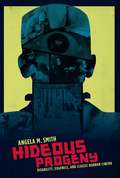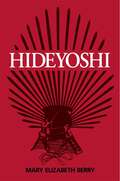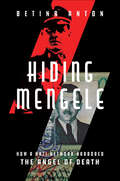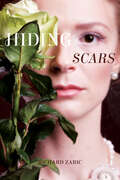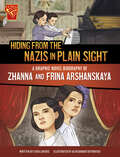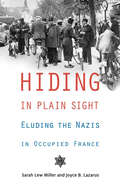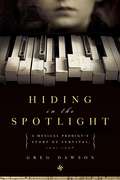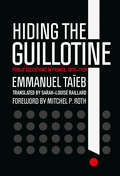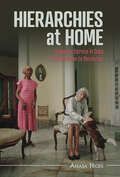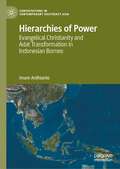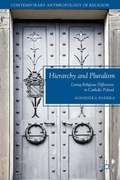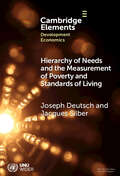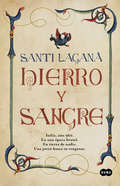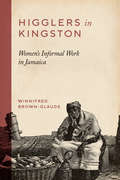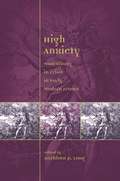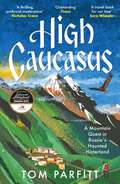- Table View
- List View
Hideous Progeny: Disability, Eugenics, and Classic Horror Cinema (Film and Culture Series)
by Angela SmithTwisted bodies, deformed faces, aberrant behavior, and abnormal desires characterized the hideous creatures of classic Hollywood horror, which thrilled audiences with their sheer grotesqueness. Most critics have interpreted these traits as symptoms of sexual repression or as metaphors for other kinds of marginalized identities, yet Angela M. Smith conducts a richer investigation into the period's social and cultural preoccupations. She finds instead a fascination with eugenics and physical and cognitive debility in the narrative and spectacle of classic 1930s horror, heightened by the viewer's desire for visions of vulnerability and transformation. Reading such films as Dracula (1931), Frankenstein (1931), Dr. Jekyll and Mr. Hyde (1931), Freaks (1932), and Mad Love (1935) against early-twentieth-century disability discourse and propaganda on racial and biological purity, Smith showcases classic horror's dependence on the narratives of eugenics and physiognomics. She also notes the genre's conflicted and often contradictory visualizations. Smith ultimately locates an indictment of biological determinism in filmmakers' visceral treatments, which take the impossibility of racial improvement and bodily perfection to sensationalistic heights. Playing up the artifice and conventions of disabled monsters, filmmakers exploited the fears and yearnings of their audience, accentuating both the perversity of the medical and scientific gaze and the debilitating experience of watching horror. Classic horror films therefore encourage empathy with the disabled monster, offering captive viewers an unsettling encounter with their own impairment. Smith's work profoundly advances cinema and disability studies, in addition to general histories concerning the construction of social and political attitudes toward the Other.
Hideyoshi (Harvard East Asian Monographs)
by Mary Elizabeth BerryHere is the first full-length biography in English of the most important political figure in premodern Japan.Hideyoshi—peasant turned general, military genius, and imperial regent of Japan—is the subject of an immense legendary literature. He is best known for the conquest of Japan’s sixteenth-century warlords and the invasion of Korea. He is known, too, as an extravagant showman who rebuilt cities, erected a colossal statue of the Buddha, and entertained thousands of guests at tea parties. But his lasting contribution is as governor whose policies shaped the course of Japanese politics for almost three hundred years.In Japan’s first experiment with federal rule, Hideyoshi successfully unified two hundred local domains under a central authority. Mary Elizabeth Berry explores the motives and forms of this new federalism which would survive in Japan until the mid-nineteenth century, as well as the philosophical question it raised: What is the proper role of government? This book reflects upon both the shifting political consciousness of the late sixteenth century and the legitimation rituals that were invoked to place change in a traditional context. It also reflects upon the architect of that change—a troubled parvenu who acted often with moderation and sometimes with explosive brutality.
Hiding Edith: A true story
by Kathy KacerHiding Edith tells the true story of Edith Schwalb, a young Jewish Girl sent to live in a safe house after the Nazi invasion of France. Edith's story is remarkable not only for her own bravery, but for the bravery of those that helped her: an entire village, including its mayor and citizenry, heroically conspired to conceal the presence of hundreds of Jewish children who lived in the safe house.
Hiding In Plain Sight: The Invention Of Donald Trump And The Erosion Of America
by Sarah KendziorThe story of Donald Trump’s rise to power is the story of a buried American history – buried because people in power liked it that way. It was visible without being seen, influential without being named, ubiquitous without being overt. <p><p> Sarah Kendzior’s Hiding in Plain Sight pulls back the veil on a history spanning decades, a history of an American autocrat in the making. In doing so, she reveals the inherent fragility of American democracy – how our continual loss of freedom, the rise of consolidated corruption, and the secrets behind a burgeoning autocratic United States have been hiding in plain sight for decades. <p> In Kendzior’s signature and celebrated style, she expertly outlines Trump’s meteoric rise from the 1980s until today, interlinking key moments of his life with the degradation of the American political system and the continual erosion of our civil liberties by foreign powers. Kendzior also offers a never-before-seen look at her lifelong tendency to be in the wrong place at the wrong time – living in New York through 9/11 and in St. Louis during the Ferguson uprising, and researching media and authoritarianism when Trump emerged using the same tactics as the post-Soviet dictatorships she had long studied. <p> It is a terrible feeling to sense a threat coming, but it is worse when we let apathy, doubt, and fear prevent us from preparing ourselves. Hiding in Plain Sight confronts the injustice we have too long ignored because the truth is the only way forward.
Hiding Mengele: How a Nazi Network Harbored the Angel of Death
by Betina AntonRead the international sensation already translated into 10 languages!Unearthing the network that hid the "Angel of Death," the infamous Nazi doctor who escaped justice for more than three decades. In 1985, six-year old Betina Antonwatched Brazilian authorities apprehend her kindergarten teacher for allegedly using documents to bury in secrecy the remains of Josef Mengele, known worldwide for cruel human experiments and for sending thousands to the Auschwitz gas chambers. Decades later, as an experienced journalist disturbed by the mysteries surrounding the departure of Austrian expat Liselotte Bossert, Anton set out to find her and see if the rumors were true. She could not imagine how deeply into Mengele's life-on-the-run her investigation would take her. Josef Mengele was a fugitive in South America for thirty-four years after World War II, sought by the Israeli secret service and Nazi Hunters. Hidden for half that time in Brazil, thanks to a small group of expatriate Europeans, Mengele created his own paradise where he could speak German with new friends, maintain his beliefs, stay one step ahead of the global manhunt, and avoid answering for his crimes.Translated from the Brazilian Tropical Bavaria edition and based on extensive research , including revelatroy interviews and never-before-seen letters and photos, Hiding Mengele is a suspenseful narrative not only haunted by the doctor's horrific actions but also by the motivations driving a community to protect an evil man.
Hiding Scars
by Richard ZaricWinnipeg 1913. Something happened to Marko Gobinski’s wife and daughter. Something horrible. The Ukrainian arrives in Winnipeg hoping to start a new life. But how can he when his past continues to haunt him? Mildred Spencer was beautiful, but not anymore. At least not since the horrible accident that left her with a grotesque scar on her face. Filled with self-doubt and apprehension in a society that doesn’t hold much regard for women, much less damaged ones, will she ever find true companionship? Can two people from wildly different classes ever be more than acquaintances? Hiding Scars follows Marko and Mildred as they struggle to find meaning and happiness during one of the most tumultuous periods of social upheaval in Canada’s history. They cope through The Great War, prohibition and the influenza epidemic, but can they survive Winnipeg’s explosive General Strike of 1919 when their past finally catches up?
Hiding from the Nazis in Plain Sight: A Graphic Novel Biography of Zhanna and Frina Arshanskaya (Barrier Breakers)
by Lydia LukidisZhanna and Frina Arshanskaya were two talented child musicians when Nazis invaded their city of Kharkiv, Ukraine, during World War II. Along with their parents, the Jewish sisters were forced into a death march. They eventually escaped individually and were reunited, but how would they survive the rest of the war? By hiding their true identities and becoming musical entertainment for German soldiers. Learn about their story of survival in this inspiring graphic novel.
Hiding in Plain Sight: Eluding the Nazis in Occupied France
by Joyce B. Lazarus Sarah Lew MillerHiding in Plain Sight: Eluding the Nazis in Occupied France is an unusual memoir about the childhood and young adulthood of Sarah Lew Miller, a young Jewish girl living in Paris at the time of the Nazi occupation.
Hiding in the Spotlight: A Musical Prodigy's Story of Survival, 1941-1946
by Greg DawsonZhanna, a young Jewish girl from Ukraine and a gifted piano prodigy giving concerts by the age of six, manages to escape the famed Nazi death march to Dorbitsky Yar and uses her musical gift to help her survive. Giving concerts for the occupying German troops as they move throughout Europe, Zhanna keeps her true identity a secret until a young American soldier adopts her. Upon her emigration to America, Zhanna's gift flourishes and she becomes one of the first Jewish refugees to enter Julliard.
Hiding the Guillotine: Public Executions in France, 1870–1939
by Emmanuel TaïebHiding the Guillotine examines the question of state involvement in violence by tracing the evolution of public executions in France. Why did the state move executions from the bloody and public stage of the guillotine to behind prison doors? In a fascinating exploration of a grim subject, Emmanuel Taïeb exposes the rituals and theatrical form of the death penalty and tells us who watched, who participated in, and who criticized (and ultimately brought an end to) a spectacle that the state called "punishment." France's abolition of the death penalty in 1981 has long overshadowed its suppression of public executions over forty years earlier. Since the Revolution, executions attracted tens of thousands of curious onlookers. But, gradually, there was a shift in attitude and the public no longer saw this as a civilized pastime. Why? Combining material from legal archives, police files, an executioner's notebooks, newspaper clippings, and documents relating to 566 executions, Hiding the Guillotine answers this question.Taïeb demonstrates the ways in which the media was at the vanguard of putting an end to the publicity surrounding the death penalty. The press had ample reason to be critical: cities were increasingly being used for leisure activity and prisons for those accused of criminal activity. The agitation surrounding each execution, coupled with a growing identification with the condemned, would blur these boundaries. Ranked among the top hundred history books by the website, Café du Web Historizo, Hiding the Guillotine has much to impart to students of legal history, human rights, and criminology, as well as to American historians.
Hierarchical Structure of the Qing Dynasty
by Junjian JingThis book analyzes the inferiors in the Qing Dynasty society, offering a comprehensive examination of their place within the feudal hierarchy. In autocratic eras, the distinction between nobility and inferiors was a cornerstone of social order, and the existence of these marginalized communities became a defining feature of the feudal hierarchy system. Drawing on interdisciplinary research spanning history, sociology, political science, economics, and jurisprudence, the work systematically explores the estates of inferiors and their internal ranks. It provides a rigorous study of the structural dynamics, historical evolution, and societal functions of the Qing dynasty&’s hierarchical system, establishing a foundational framework for understanding China&’s feudal social order.
Hierarchies at Home: Domestic Service in Cuba from Abolition to Revolution (Afro-Latin America)
by Anasa HicksHierarchies at Home traces the experiences of Cuban domestic workers from the abolition of slavery through the 1959 revolution. Domestic service – childcare, cleaning, chauffeuring for private homes – was both ubiquitous and ignored as formal labor in Cuba, a phenomenon made possible because of who supposedly performed it. In Cuban imagery, domestic workers were almost always black women and their supposed prevalence in domestic service perpetuated the myth of racial harmony. African-descended domestic workers were 'like one of the family', just as enslaved Cubans had supposedly been part of the families who owned them before slavery's abolition. This fascinating work challenges this myth, revealing how domestic workers consistently rejected their invisibility throughout the twentieth century. By following a group marginalized by racialized and gendered assumptions, Anasa Hicks destabilizes traditional analyses on Cuban history, instead offering a continuous narrative that connects pre- and post-revolutionary Cuba.
Hierarchies of Power: Evangelical Christianity and Adat Transformation in Indonesian Borneo (Contestations in Contemporary Southeast Asia)
by Imam ArdhiantoThis book focuses on a Pentecostal-Evangelical Kenyah community in central Borneo, a region that crosses the border between Malaysia and Indonesia. The book argues that the Pentecostal-Evangelical (P/e) mode of religious authority and organization has the capacity to adapt to both the pre-existing hierarchical traditional institution such as Adat and modern egalitarian social forms. It has been necessary within the context of Kenyah’s experience of religious change as it enabled many actors from various social classes to obtain and perceive religious authority in a specific local and regional political-religious situation while promoting their identity as egalitarian and autonomous modern subjects. In contrast with other studies on the P/e church that emphasize its egalitarian spirit as a factor that supports its impressive growth, the book contends that its adaptive structural characteristics have enabled the development of this specific Christian denomination to expand rapidly and play a dominant position in contemporary social life in various parts of the world. The book thus provides novel findings in the study of religious change in Southeast Asia by enriching the discussion of historical transformation in the region, and analyzing the articulation of global and regional Christian movements, with the socio-political characteristics of Bornean society.
Hierarchy and Pluralism
by Agnieszka PasiekaBased on an ethnographic study of rural Poland, this book investigates the challenges of maintaining pluralism in a religiously homogenous society. By examining a multireligious and multiethnic community, Pasieka reveals paradoxes inscribed into the practice and discourse of pluralism.
Hierarchy of Needs and the Measurement of Poverty and Standards of Living (Elements in Development Economics)
by Joseph Deutsch Jacques SilberThe focus of this Element is on the idea that choice is hierarchical so that there exists an order of acquisition of durable goods and assets as real incomes increase. Two main approaches to deriving such an order are presented, the so-called Paroush approach and Item Response Theory. An empirical illustration follows, based on the 2019 Eurobarometer Survey. The Element ends with two sections showing first how measures of inequality, poverty and welfare may be derived from such an order of acquisition, second that there is also an order of curtailment of expenditures when individuals face financial difficulties. This title is also available as Open Access on Cambridge Core.
Hieroglyphic Vocabulary to the Book of the Dead (Egypt Ser.)
by E. A. Wallis BudgeIndispensable reference by noted Egyptologist contains every word of ancient Egyptian text, vital repository of Egyptian religious doctrine, grouped according to hieroglyphic symbols in the standard scholarly system of Roman alphabetization. A phonetic version and definition are provided for each word, along with a helpful Index to English equivalents of Egyptian words in the text. Second, revised edition.
Hieroglyphs: A Very Short Introduction
by Penelope WilsonHieroglyphs were far more than a language. They were an omnipresent and all-powerful force in communicating the messages of ancient Egyptian culture for over three thousand years; used as monumental art, as a means of identifying Egyptianness, and for rarefied communication with the gods. In this exciting new study, Penelope Wilson explores the cultural significance of the script with an emphasis on previously neglected areas such as cryptography, the continuing decipherment into modern times, and examines the powerful fascination hieroglyphs still hold for us today.
Hierro y sangre
by Santi LaganàEn un tiempo corrupto y violento, una mujer inquebrantable hará lo imposible por salvar a quien más quiere. El siglo x llega a su fin, en el trono papal se sienta un adolescente caprichoso y libertino, el resto de Italia se desangra en luchas internas y los campos son una tierra de nadie donde se impone la ley del más fuerte. Cuando la fama de la extraordinaria belleza de Anna, la hija de quince años de una pobre familia campesina, llega a oídos del joven papa Juan sobre su hogar se cierne la amenaza de un cruel señor que pretende venderla como esclava en la depravada corte romana. Aunque logra escapar a su destino, Anna presencia cómo el resto de su familia es masacrada y su hermano Martello es capturado. En ese momento, la joven decide que hará lo que sea necesario para rescatarlo y, con una determinación indómita, parte en su busca en un mundo hostil y brutal. En su camino encontrará a un caballero con un oscuro pasado y un aún más misterioso presente, a un anciano erudito de insospechados recursos y a un joven alegre y audaz. Una extraña compañía con la que Anna tratará de alcanzar los palacios más secretos de Roma dispuesta a encontrar a su hermano y ejercer su venganza. Un ambicioso y vívido retrato de la Italia medieval en una novela emocionante de aventuras, violencia y pasiones. En los blogs:«Un libro intenso, potente y profundo que aconsejo leer saboreándolo sin prisa.»La testa fra i libri «La valentía, la determinación, el orgullo y las ganas de vivir convierten esta novela en una historia compleja y nada predecible que cuenta con una escritura intensa y atenta a todos los personajes y a una historia que resultará inolvidable... La intensidad y majestuosidad de estas páginas lleva al lector al descubrimiento de todo un mundo.»Il mondo di sopra «Ambientaciones muy cuidadas y personajes bien trazados, de los campesinos a los nobles y cardenales, pasando por bárbaros y sarracenos... Se lo recomiendo a todos los lectores, absolutamente a todos.»Il club delle lettrici compulsive «Una novela de extraordinaria potencia... La ficción se funde con la realidad histórica en una trama apasionante y absorbente en la que una mujer se convierte en símbolo y heroína en un periodo aún más difícil para su género.»In punta di Carta «Una historia que arrastra, que envuelve, que emociona... Son páginas que contienen mucha violencia, pero aún más esperanza.»The Shelter of Books «Una novela que induce a reflexionar sobre el mundo de ayer y de hoy, y sobre los derechos que ahora tenemos gracias a mujeres como Anna que no se plegaron a los hombres que las querían vulnerables y fáciles de doblegar.»Non solo Il libro dello scrittore «Se lo aconsejo a todos los aficionados al género histórico que amen las aventuras.»Gli occhi del lupo
Higglers in Kingston: Women's Informal Work in Jamaica
by Winnifred Brown-GlaudeMaking a living in the Caribbean requires resourcefulness and even a willingness to circumvent the law. Women of color in Jamaica encounter bureaucratic mazes, neighborhood territoriality, and ingrained racial and cultural prejudices. For them, it requires nothing less than a herculean effort to realize their entrepreneurial dreams. In Higglers in Kingston, Winnifred Brown-Glaude puts the reader on the ground in frenetic urban Kingston, the capital and largest city in Jamaica. She explores the lives of informal market laborers, called "higglers," across the city as they navigate a corrupt and inaccessible "official" Jamaican economy. But rather than focus merely on the present-day situation, she contextualizes how Jamaica arrived at this point, delving deep into the island's history as a former colony, a home to slaves and masters alike, and an eventual nation of competing and conflicted racial sectors.Higglers in Kingston weaves together contemporary ethnography, economic history, and sociology of race to address a broad audience of readers on a crucial economic and cultural center.
High Anxiety: Masculinity in Crisis in Early Modern France (Sixteenth Century Essays & Studies #59)
by Kathleen P. LongThis collection explores the evolution of notions about masculinity during the intense crisis of Renaissance and early modern France. Authors of the period reflect the anxieties about masculinity that became more pronounced against the backdrop of major events and innovations of the period: the religious conflict in France, the repeated questioning of religious and royal authority, the revival of Greek skepticism, the discovery of the New World, and the rise of clinical medicine. These events in turn fueled growing doubt concerning the fixed and hierarchical nature of gender distinction, a distinction upon which many felt French culture was dependent for its very survival.
High Anxiety: Masculinity in Crisis in Early Modern France (Sixteenth Century Essays & Studies)
by Kathleen P. LongThis collection explores the evolution of notions about masculinity during the intense crisis of Renaissance and early modern France. Authors of the period reflect the anxieties about masculinity that became more pronounced against the backdrop of major events and innovations of the period: the religious conflict in France, the repeated questioning of religious and royal authority, the revival of Greek skepticism, the discovery of the New World, and the rise of clinical medicine. These events in turn fueled growing doubt concerning the fixed and hierarchical nature of gender distinction, a distinction upon which many felt French culture was dependent for its very survival.
High Bonnet: A Novel of Epicurean Adventures
by Idwal JonesThe chef's towering white toque, the high bonnet, is the mark of achievement to which every young sauce-stirrer aspires. Idwal Jones's urbane novel follows the young provincial Jean as he attempts to master culinary art at the hands of Paris's most distinguished chefs. Jean will win his high bonnet and the royal bearing that accompanies it - but not until he's had many outrageous adventures, in the kitchen and out. High Bonnetis a sly send-up of the seething politics, subtle artistry, and enslavement to the palate that constitute life behind the kitchen's swinging doors. First published in 1945 and out of print for more than four decades,High Bonnetwill delight readers of Anthony Bourdain's bestsellingKitchen Confidentialor of Ludwig Bemelmans'sHotel Splendide.
High Bridge (Postcard History)
by William Honachefsky Jr.The history of High Bridge is intertwined with the development of the iron and steel industry in the United States. As early as the 1700s, the framework of this little hamlet had already been created by English investors who carved up the rich wilderness of the New World, brimming with iron ore that would be essential to the county's development. High Bridge Borough evolved around the Taylor Wharton Foundry, established in 1742. With the passage of time, however, High Bridge has lost its farming and foundry roots, evolving into what is often referred to as a bedroom community. Just like the lofty trestle from which High Bridge derived its name, the city now runs the risk of being lost to time, forsaking the resilient character of the immigrants who forged a nation. This book aims to preserve High Bridge's glorious history for future generations.
High Caucasus: A Mountain Quest in Russia’s Haunted Hinterland
by Tom ParfittA wonderfully atmospheric memoir-cum-travel narrative about how British journalist Tom Parfitt walked a thousand miles across Russia's Caucasus mountains to lay to rest a ghost after witnessing the carnage of the Beslan school siege in 2004.On 1 September 2004, Chechen and Ingush militants took more than a thousand people captive at a school in the Caucasus region of southern Russia. Working as a correspondent, Tom Parfitt witnessed the bloody climax in which 314 hostages died, more than half of them children. The experience left Tom emotionally shredded, struggling to find a way to return to his life in Moscow and put to rest the ghosts of the Beslan siege.Having long been fascinated by the mountainous North Caucasus, Tom turned to his love of walking as a source of both recuperation and discovery. In High Caucasus, he shares his remarkable thousand-mile quest in search of personal peace - and a greater understanding of the roots of violence in a region whose fate has tragic parallels with the Ukraine of today.Starting his journey in Sochi on the Black Sea and walking the mountain ranges to Derbent, the ancient fortress city on the Caspian, Tom traverses the political, religious and ethnic fault-lines of seven Russian republics, including Chechnya and Dagestan. Through bear-haunted forests, across high altitude pastures and over the shoulders of Elbrus, Europe's highest mountain, he finds companionship and respite in the homes of proud, little-known peoples. Walking exerts a restorative power; it also provides a unique, ground-level view of a troubled yet exquisite corner of the world.High Caucasus is a stunning memoir of confronting trauma through connection with history, people and place.'A thrilling and beautiful book' Philip Marsden'Tom Parfitt has re-invented travel writing for the 21st century' Oliver Bullough(P)2023 Headline Publishing Group Limited
High Caucasus: A Mountain Quest in Russia’s Haunted Hinterland
by Tom Parfitt'A thrilling and beautiful book' Philip Marsden'Tom Parfitt has re-invented travel writing for the 21st century' Oliver BulloughOn 1 September 2004, Chechen and Ingush militants took more than a thousand people captive at a school in the Caucasus region of southern Russia. Working as a correspondent, Tom Parfitt witnessed the bloody climax in which 314 hostages died, more than half of them children. The experience left Tom emotionally shredded, struggling to find a way to return to his life in Moscow and put to rest the ghosts of the Beslan siege.Having long been fascinated by the mountainous North Caucasus, Tom turned to his love of walking as a source of both recuperation and discovery. In High Caucasus, he shares his remarkable thousand-mile quest in search of personal peace - and a greater understanding of the roots of violence in a region whose fate has tragic parallels with the Ukraine of today.Starting his journey in Sochi on the Black Sea and walking the mountain ranges to Derbent, the ancient fortress city on the Caspian, Tom traverses the political, religious and ethnic fault-lines of seven Russian republics, including Chechnya and Dagestan. Through bear-haunted forests, across high altitude pastures and over the shoulders of Elbrus, Europe's highest mountain, he finds companionship and respite in the homes of proud, little-known peoples. Walking exerts a restorative power; it also provides a unique, ground-level view of a troubled yet exquisite corner of the world.High Caucasus is a stunning memoir of confronting trauma through connection with history, people and place.
